1997 GMC SIERRA flat tire
[x] Cancel search: flat tirePage 3 of 436

The 1997 GMC Sierra Owner’s Manual
1-1
2- 1
3- 1
4- 1
5-1
6-1
7- 1
8-1
9-1
Seats and Restraint Systems
This section tells you how to use your seats and safety belts properly. It also explains the “SIR’ system.
Features and Controls
This section explains how to start and operate your vehicle.
Comfort Controls and Audio Systems
This section tells you how to adjust the ventilation and comfort controls and how to operate your audio system.
Your Driving and the Road
Here you’ll find helpful information and tips about the road and how to drive under different conditions.
Problems on the Road
This section tells what to do if you have a problem while driving, such as a flat tire or overheated engine, etc.
Service and Appearance Care
Here the manual tells you how to keep your vehicle running properly and looking good.
Maintenance Schedule
This section tells you when to perform vehicle maintenance and what fluids and lubricants to use.
Customer Assistance Information
This section tells you how to contact GMC for assistance and how to get service and owner publications.
It also gives you information on “Reporting Safety Defects” on page
8- 10.
Index
Here’s an alphabetical listing of almost every subject in this manual. You can use it to quickly find
something you want to read.
ProCarManuals.com
Page 16 of 436
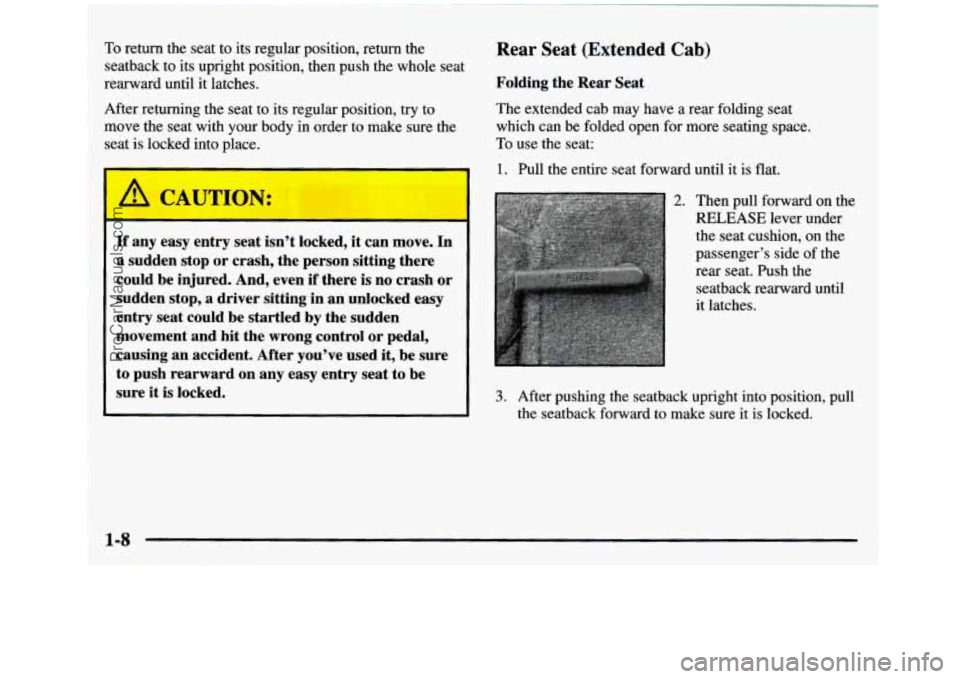
To return the seat to its regular position, return the
seatback to its upright position, then push the whole seat
rearward until it latches.
After returning the seat to its regular position, try to
move the seat with your body
in order to make sure the
seat
is locked into place.
If any easy entry seat isn’t locked, it can move. In
a sudden stop or crash, the person sitting there
could be injured. And, even
if there is no crash or
sudden stop, a driver sitting in an unlocked
easy
entry seat could be startled by the sudden
movement and hit the wrong control or pedal,
causing an accident. After you’ve used it, be sure
to push rearward
on any easy entry seat to be
sure it is locked.
Rear Seat (Extended Cab)
Folding the Rear Seat
The extended cab may have a rear folding seat
which can be folded open for more seating space.
To use the seat:
1. Pull the entire seat forward until it is flat.
2. Then pull forward on the
RELEASE lever under
the seat cushion, on the
passenger’s side of the
rear seat. Push the
seatback rearward until
it latches.
3. After pushing the seatback upright into position, pull
the seatback forward to make sure it
is locked.
1-8
I
ProCarManuals.com
Page 17 of 436

The extended cab's rear seat can also be folded up to
provide more cargo space. To
fold the seat:
1. Pull forward on the RELEASE lever at the side of
the seat cushion, behind the passenger's side front
seat. Fold the seatback forward
until it latches with
the seat cushion.
2. Lift the entire seat and
push
it rearward into
place.
3. Make sure the seat is secure.
Rear Seat (Crew Cab)
You can adjust the seat by sliding the lever at the front
of the seat toward the seat support to unlock it. Then,
slide the seat to where you want
it. Release the lever and
try to move the seat with your body
in order to make
sure the seat
is locked into place.
Safety Belts: They're for Everyone
This part of the manual tells you how to use safety belts
properly. It also tells you some things you should not do
with safety belts.
And
it explains the Supplemental Inflatable Restraint
system, or air bag system.
A CAUTION:
- -
Don't let anyone ride where he or she can't wear
a safety belt properly. If you are in a crash and
you're not wearing
a safety belt, your injuries
can be much worse. You can hit things inside the
vehicle or be ejected from it.
You can be seriously
injured or killed. In the same crash, you might
not be
if you are buckled up. Always fasten your
safety belt, and check that your passengers' belts
are fastened properly too.
1-9
ProCarManuals.com
Page 193 of 436
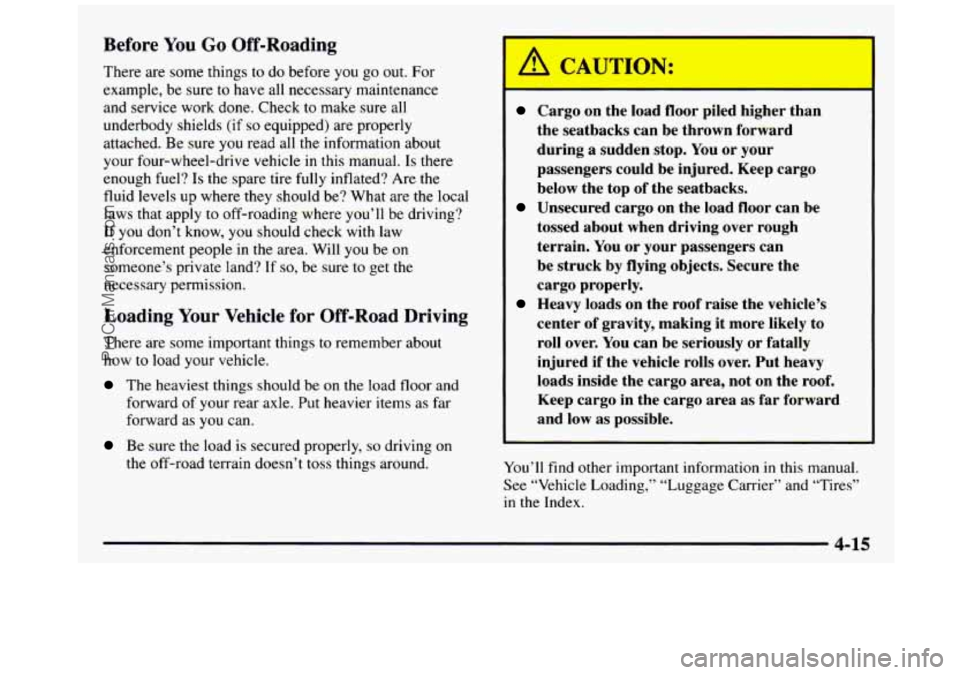
Before You Go Off-Roading
There are some things to do before you go out. For
example, be sure to have all necessary maintenance
and service work done. Check to make sure all
underbody shields
(if so equipped) are properly
attached. Be sure you
read all the information about
your four-wheel-drive vehicle in this manual.
Is there
enough fuel?
Is the spare tire fully inflated? Are the
fluid levels up where they should be? What are the local
laws that apply to off-roading where you’ll be driving?
If you don’t know, you should check
with law
enforcement people
in the area. Will you be on
someone’s private land?
If so, be sure to get the
necessary permission.
Loading Your Vehicle for Off-Road Driving
There are some important things to remember about
how to load your vehicle.
The heaviest things should be on the load floor and
forward
of your rear axle. Put heavier items as far
forward as you can.
Be sure the load is secured properly, so driving on
the off-road terrain doesn’t toss things around.
Cargo on the load floor piled higher than
the seatbacks can be thrown forward
during a sudden stop. You or your
passengers could be injured. Keep cargo
below the top of the seatbacks.
Unsecured cargo on the load floor can be
tossed about when driving over rough
terrain. You or your passengers can
be struck
by flying objects. Secure the
cargo properly.
Heavy loads on the roof raise the vehicle’s
center of gravity, making it more likely to
roll over. You can be seriously or fatally
injured
if the vehicle rolls over. Put heavy
loads inside the cargo area, not on the roof.
Keep cargo in the cargo area as far forward
and low
as possible.
You’ll find other important information
in this manual.
See “Vehicle Loading,” “Luggage Carrier” and “Tires”
in the Index.
ProCarManuals.com
Page 212 of 436
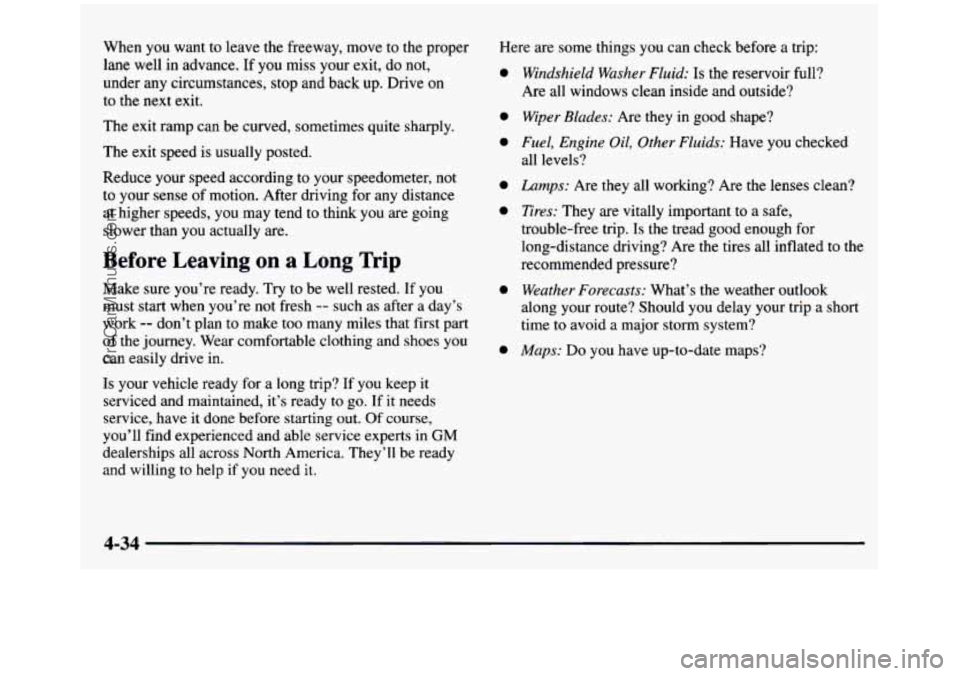
When you want to leave the freeway, move to the proper
lane well in advance. If you miss your exit, do not,
under any circumstances,
stop and back up. Drive on
to the next exit.
The exit ramp can be curved, sometimes quite sharply.
The exit speed is usually posted.
Reduce your speed according to your speedometer, not
to your sense of motion. After driving for any distance
at higher speeds,
you may tend to think you are going
slower than you actually are.
Before Leaving on a Long Trip
Make sure you’re ready. Try to be well rested. If you
must
start when you’re not fresh -- such as after a day’s
work
-- don’t plan to make too many miles that first part
of the journey. Wear comfortable clothing and shoes you
can easily drive in.
Is your vehicle ready for a long trip?
If you keep it
serviced and maintained, it’s ready to go. If it needs
service, have
it done before starting out. Of course,
you’ll find experienced and able service experts in
GM
dealerships all across North America. They’ll be ready
and willing to help
if you need it.
Here are some things you can check before a trip:
0
0
0
0
a
Windshield Washer Fluid: Is the reservoir full?
Are all windows clean inside and outside?
Wiper Blades: Are they in good shape?
Fuel, Engine Oil, Other Fluids: Have you checked
all levels?
Lamps: Are they all working? Are the lenses clean?
Tires: They are vitally important to a safe,
trouble-free trip. Is the tread good enough for
long-distance driving? Are the tires all inflated to the
recommended pressure?
Weather Forecasts: What’s the weather outlook
along your route? Should you delay your trip a short
time to avoid
a major storm system?
Maps: Do you have up-to-date maps?
ProCarManuals.com
Page 213 of 436

Highway Hypnosis
Is there actually such a condition as “highway hypnosis”?
Or is it just plain falling asleep at the wheel? Call it
highway hypnosis, lack
of awareness, or whatever.
There is something about an easy stretch
of road with the
same scenery, along with the hum of the tires on the road,
the drone of the engine, and
the rush of the wind against
the vehicle that can make you sleepy. Don’t let it happen
to you! If it does, your vehicle can leave the road in
less
than a second, and you could crash and be injured.
What can you do about highway hypnosis? First, be
aware that it can happen.
Then here are some tips:
0
e
0
Make sure your vehicle is well ventilated, with a
comfortably cool interior.
Keep your eyes moving. Scan the road ahead
and
to the sides, Check your mirrors and your
instruments frequently.
If you get sleepy, pull off the road into
a rest, service
or parking area and take a nap, get some exercise, or
both. For safety, treat drowsiness
on the highway as
an emergency.
Hill and Mountain Roads
Driving on steep hills or mountains is different from
driving in flat or rolling terrain.
4-35
ProCarManuals.com
Page 219 of 436
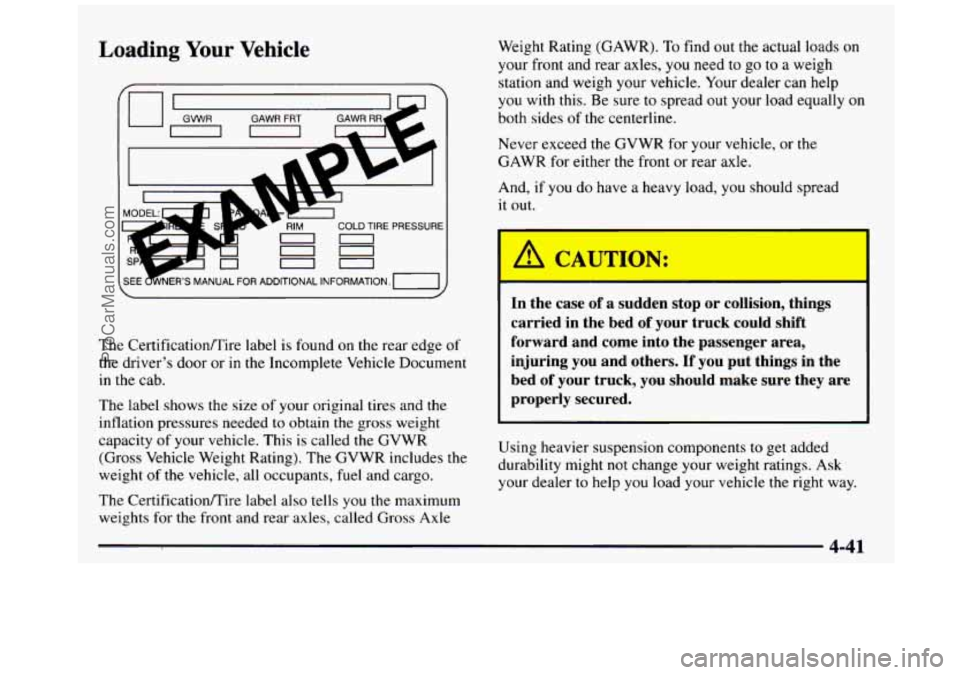
Loading Your Vehicle
I-
GAWR FRT
RIM COLD TIRE PRESSURE
-!=2 - I
The Certificationrnire label is found on the rear edge of
the driver’s door or in the Incomplete Vehicle Document
in the cab.
The label shows the size of
your original tires and the
inflation pressures needed to obtain the gross weight
capacity
of your vehicle. This is called the GVWR
(Gross Vehicle Weight Rating). The GVWR includes the
weight
of the vehicle, all occupants, fuel and cargo.
The Certificationmire label also tells you the maximum
weights for the front and rear axles, called Gross Axle Weight Rating (GAWR). To find out the actual loads on
your front and rear axles, you need
to go to a weigh
station
and weigh your vehicle. Your dealer can help
you
with this. Be sure to spread out your load equally on
both sides of the centerline.
Never exceed the
GVWR for your vehicle, or the
GAWR for
either the front or rear axle.
And, if you do have a heavy load, you should spread
it out.
/;1 CAUTION:
In the case of a den stop or collision, things
carried in the bed of your truck could shift
forward and come into the passenger area,
injuring you and others. If you put things in the
bed
of your truck, you should make sure they are
properly secured.
Using heavier suspension components to get added
durability might not change your weight ratings. Ask
your dealer to help you load
your vehicle the right way.
4-41
ProCarManuals.com
Page 231 of 436
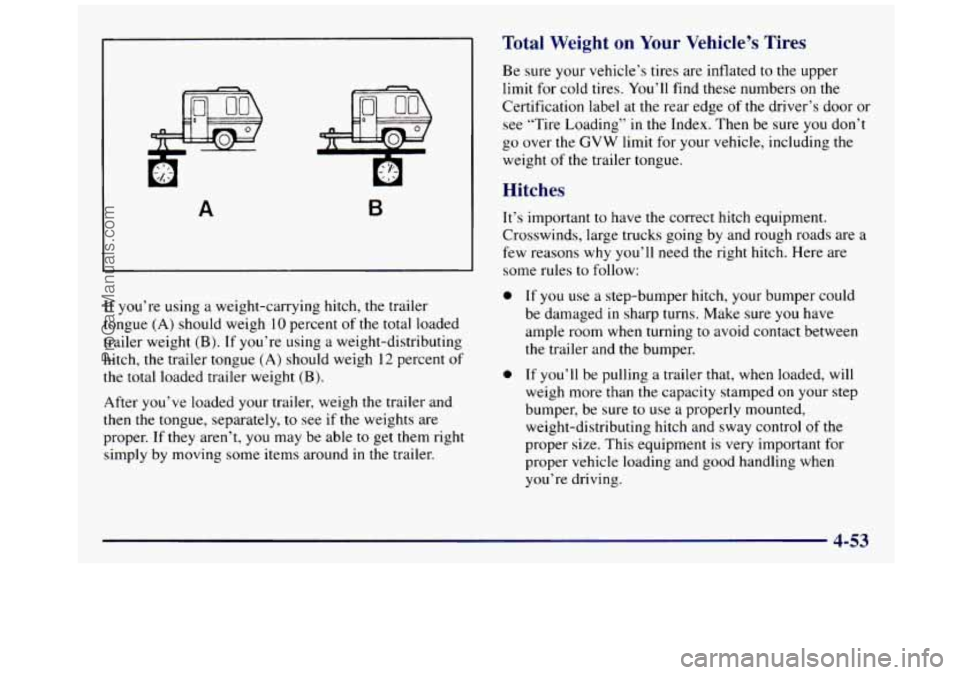
A B
If you’re using a weight-carrying hitch, the trailer
tongue
(A) should weigh 10 percent of the total loaded
trailer weight
(B). If you’re using a weight-distributing
hitch, the trailer tongue
(A) should weigh 12 percent of
the total loaded trailer weight (B).
After you’ve loaded your trailer, weigh the trailer and
then
the tongue, separately, to see if the weights are
proper. If they aren’t,
you may be able to get them right
simply by moving some items around
in the trailer.
Total Weight on Your Vehicle’s Tires
Be sure your vehicle’s tires are inflated to the upper
limit for cold tires. You’ll find these numbers on the
Certification label at the rear edge
of the driver’s door or
see “Tire Loading”
in the Index. Then be sure you don’t
go over the GVW limit for your vehicle, including the
weight of the trailer tongue.
Hitches
It’s important to have the correct hitch equipment.
Crosswinds, large trucks going by and rough roads are a
few reasons why
you’ll need the right hitch. Here are
some rules to follow:
0 If you use a step-bumper hitch, your bumper could
be damaged in sharp turns. Make sure
you have
ample room when turning
to avoid contact between
the trailer and the bumper.
0 If you’ll be pulling a trailer that, when loaded, will
weigh more than
the capacity stamped on your step
bumper, be sure
to use a properly mounted,
weight-distributing hitch and sway control of the
proper size. This equipment
is very important for
proper vehicle loading and good handling when
you’re driving.
4-53
ProCarManuals.com